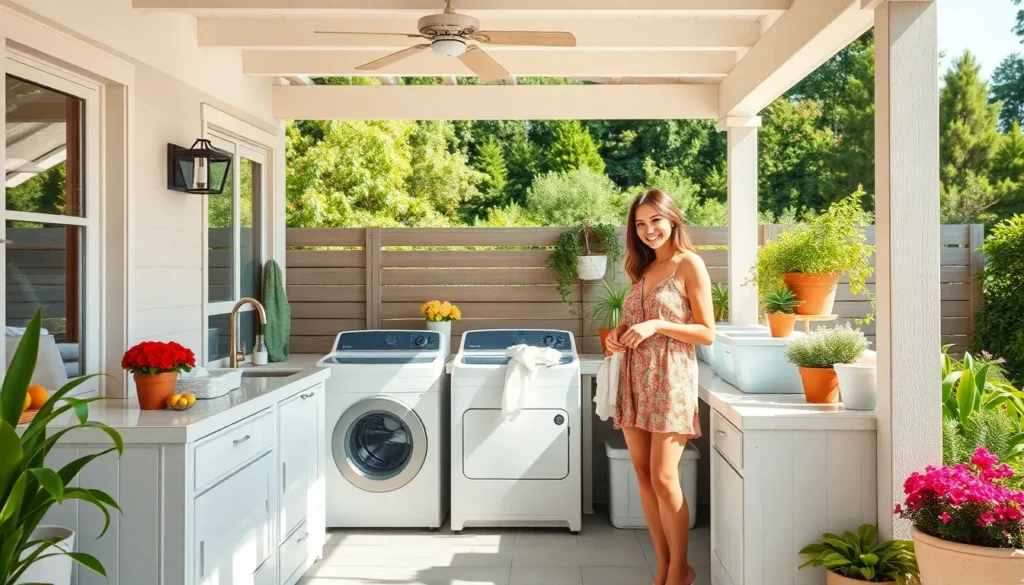We’ve all been there – cramped laundry rooms that feel more like closets and utility areas that steal precious indoor space from our homes. Moving your washer and dryer outdoors isn’t just a space-saving solution; it’s a game-changer that transforms how you approach household chores while adding functionality to your outdoor living areas.
Outdoor laundry setups offer incredible benefits beyond just freeing up indoor square footage. You’ll enjoy better ventilation that eliminates humidity issues and reduces lint buildup that often plagues indoor installations. Plus there’s something satisfying about handling laundry in fresh air rather than a stuffy utility room.
Whether you’re working with a spacious backyard or a compact patio we’ll explore creative answers that protect your appliances from the elements while maintaining easy access and functionality. From simple covered alcoves to fully enclosed outdoor laundry rooms these ideas will help you create an efficient washing station that works year-round.
Create a Dedicated Outdoor Laundry Room
Building a dedicated outdoor laundry room transforms your washing experience while maximizing your home’s interior space. We’ll guide you through creating a functional washing sanctuary that withstands the elements year-round.
Choose Weather-Resistant Materials
Concrete flooring provides the most durable foundation for outdoor laundry rooms, offering water resistance and easy maintenance. We recommend sealing concrete surfaces every 2-3 years to prevent moisture damage and staining from detergent spills.
Pressure-treated lumber works excellently for framing walls and support structures in outdoor laundry spaces. Cedar and redwood naturally resist moisture and insects, making them ideal choices for shelving, cabinets, and decorative elements.
Vinyl siding offers superior weather protection compared to traditional wood siding, requiring minimal maintenance while providing excellent insulation. Metal roofing materials like galvanized steel or aluminum create long-lasting overhead protection that won’t warp or rot.
Composite decking materials serve as excellent alternatives to traditional wood for flooring and shelving applications. These materials resist fading, moisture, and temperature fluctuations better than natural wood options.
Install Proper Ventilation Systems
Exhaust fans rated for outdoor use should move at least 50 cubic feet per minute to effectively remove moisture and lint from your laundry space. We suggest installing fans with automatic humidity sensors that activate when moisture levels exceed 60%.
Ridge vents along the roofline create natural airflow that prevents condensation buildup without requiring electricity. Soffit vents installed under the eaves work along with ridge vents to establish continuous air circulation.
Louvered panels in walls allow for cross-ventilation while keeping rain and debris out of your laundry area. Position these panels on opposite walls to create effective air movement patterns that reduce humidity accumulation.
Dryer vent systems must extend at least 4 feet from the building exterior to prevent moisture and lint from accumulating near your outdoor laundry room. Use rigid metal ductwork instead of flexible plastic tubing for better airflow and reduced fire risk.
Add Storage Answers for Supplies
Weather-resistant cabinets made from marine-grade plywood or high-density polyethylene keep detergents and fabric softeners safe from temperature fluctuations. We recommend installing cabinets at least 12 inches above ground level to prevent moisture damage.
Sealed storage containers protect bulk supplies like laundry pods and powdered detergents from humidity and pests. Choose containers with tight-fitting lids and consider adding desiccant packets for extra moisture control.
Wall-mounted organizers maximize vertical space while keeping frequently used items within easy reach. Install these systems using corrosion-resistant hardware that can withstand outdoor conditions.
Utility sinks with hot and cold water connections provide convenient spaces for pretreating stains and hand washing delicate items. Stainless steel or composite materials resist rust and staining better than traditional porcelain options.
Build a Covered Patio Laundry Station
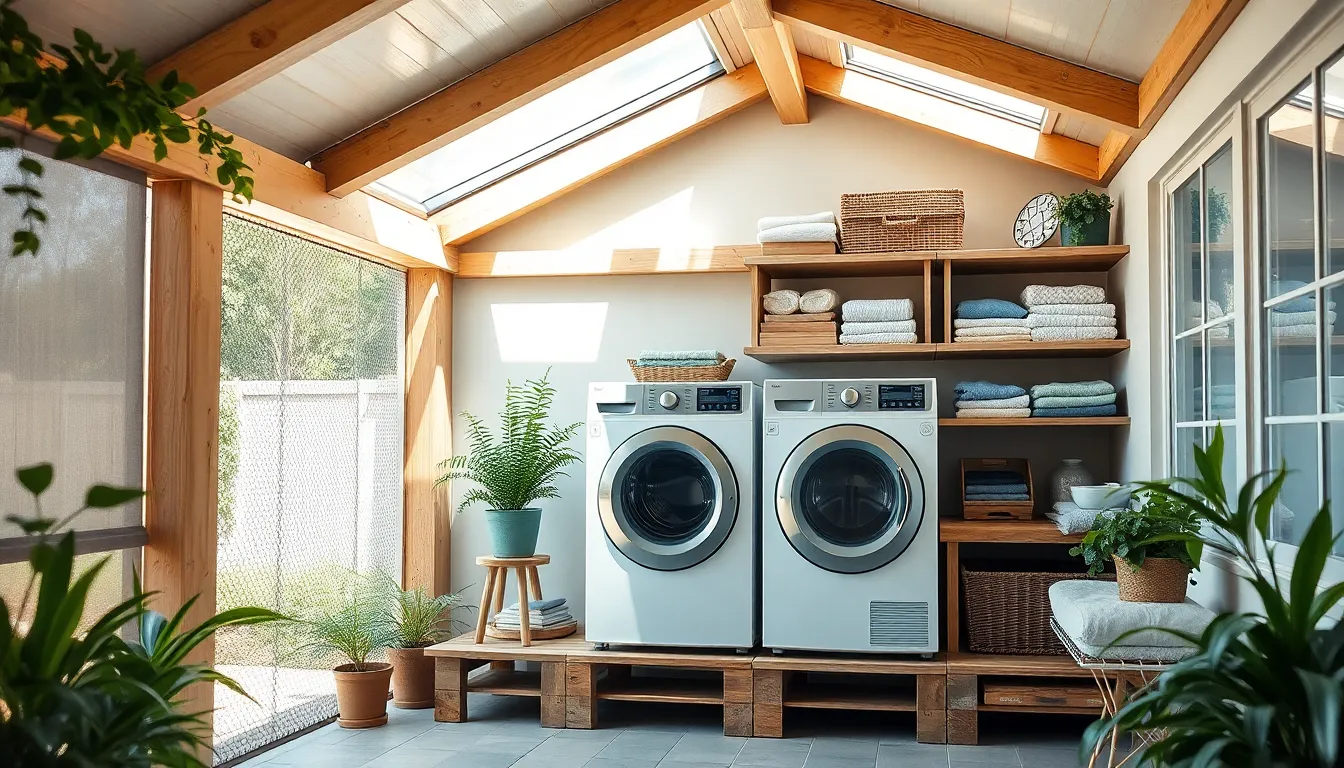
Building a covered patio laundry station offers the perfect balance between outdoor convenience and weather protection. This approach shields your appliances from direct exposure to rain, sun, and debris while maintaining excellent ventilation for optimal performance.
Design an Open-Air Structure
Creating an open-air laundry structure resembles building a small shed, pergola, or screened-in patio that maximizes airflow while protecting your machines. Natural ventilation prevents moisture buildup and eliminates odors that can plague enclosed indoor laundry rooms.
Positioning washers and dryers on raised platforms elevates them above potential water damage and improves accessibility for maintenance. Farm-inspired storage answers and rustic design elements complement the outdoor aesthetic while providing practical organization space.
Installing waterproof tiling or durable finishes on floors and walls protects surfaces from water splashes and humidity damage. These materials also reduce noise transmission from operating machines, making the space more pleasant for nearby outdoor activities.
Include Electrical and Plumbing Access
Establishing proper utility connections forms the foundation of any successful outdoor laundry installation. Running hot and cold water supply lines with appropriate shut-off valves ensures reliable water access for your washing machine.
Directing drainage safely away from the structure prevents water accumulation and potential foundation damage. Integration with existing outdoor kitchen or patio water lines simplifies installation and reduces overall project costs.
Installing GFCI-protected electrical outlets rated for outdoor use provides safe power connections for your appliances. Proper grounding and weatherproof electrical boxes prevent safety hazards and ensure code compliance.
Routing dryer venting through exterior walls or choosing ventless models eliminates moisture concerns in covered spaces. Flexible PEX piping and secure ducting materials make installation more manageable while ensuring long-term durability.
Incorporate Natural Lighting Elements
Maximizing natural light transforms your covered laundry station into a bright, welcoming workspace that reduces electricity costs. Installing skylights, translucent roofing panels, or large screened openings floods the area with sunlight throughout the day.
Strategic positioning balances daylight exposure with protection from direct sun that can overheat appliances or fade stored fabrics. This thoughtful placement ensures comfortable working conditions while maintaining equipment efficiency.
Natural lighting makes covered spaces feel larger and more open, improving the overall outdoor laundry experience. Abundant daylight also improves visibility for sorting clothes and performing maintenance tasks on your appliances.
Install Under-Deck Laundry Setup
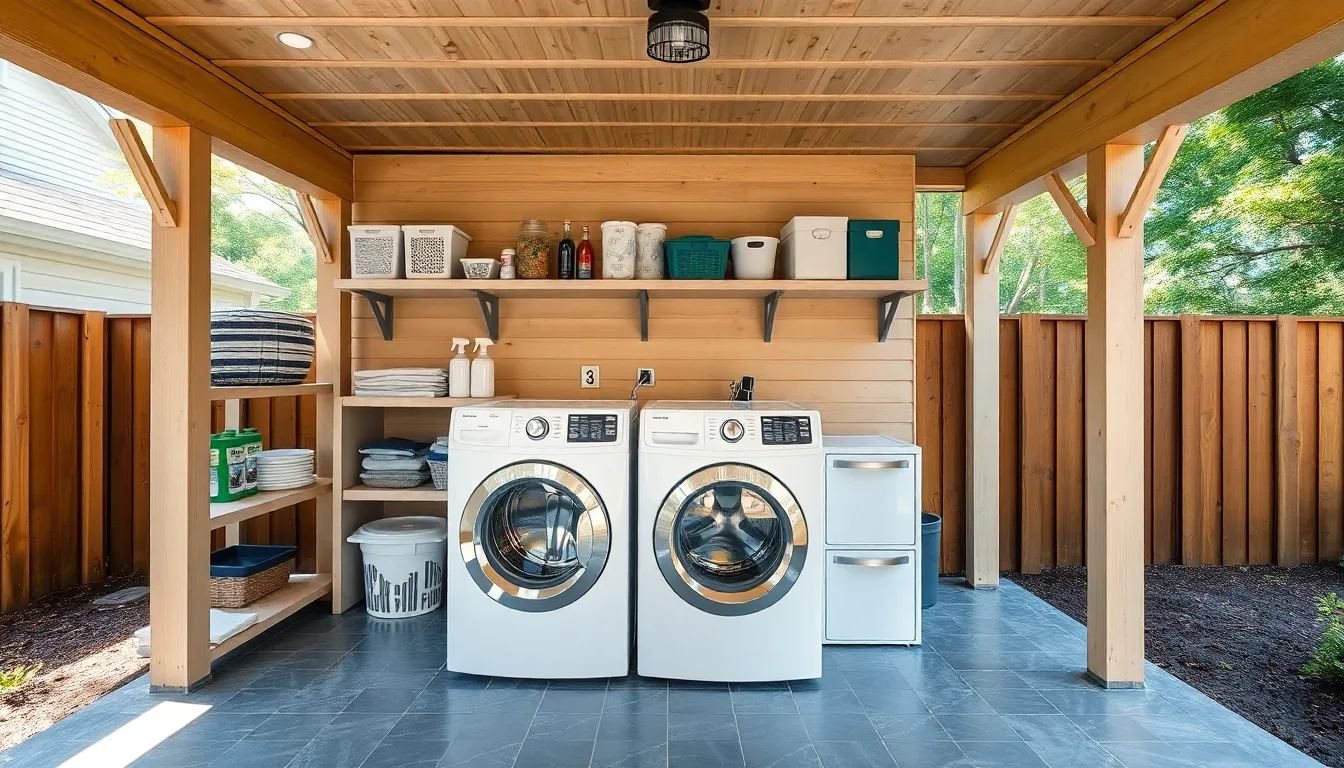
We can transform the unused space beneath our deck into a functional laundry area that provides natural weather protection while maximizing our outdoor living space. This creative solution leverages the deck’s overhead coverage to shield appliances from rain and direct sunlight.
Use Existing Deck Structure
Our deck’s existing framework provides an excellent foundation for housing washers and dryers with strategic modifications for essential utilities. We’ll need to integrate plumbing lines by teeing into our home’s existing water supply and drainage systems, ensuring proper connections for both hot and cold water. Electrical work requires installing GFCI-protected outlets that meet outdoor safety standards for appliance operation.
Structural reinforcements become necessary to support the weight of our appliances, particularly when we’re mounting them on elevated platforms or custom countertops. We can add additional bracing under the deck joists and install support beams where needed. Vented dryers require careful ducting installation that routes discreetly along deck posts or exterior walls, maintaining both functionality and aesthetic appeal.
Platform construction elevates our machines above ground moisture and potential flooding, using pressure-treated lumber or composite materials for durability. We should install waterproof flooring such as tile or marine-grade decking materials to create a moisture-resistant surface beneath our appliances.
Ensure Adequate Drainage Systems
Proper water management prevents costly damage and ensures our under-deck laundry setup functions reliably throughout all seasons. We must install P-traps and dedicated drain lines that connect either to our home’s main drainage system or a separate outdoor drainage solution. Water supply lines require weatherproofing with appropriate insulation and shutoff valves for seasonal maintenance.
Building a watershed system involves creating sloped flooring that directs excess water away from our appliances and deck structure. We can construct a slight grade using self-leveling compounds or tapered sleepers beneath our flooring materials. French drains or catch basins positioned strategically around the perimeter collect and redirect water runoff.
Emergency overflow protection includes installing floor drains near our washing machine and creating channels that guide water toward designated drainage points. We should seal all connections with marine-grade caulking and use rust-resistant hardware to maintain system integrity over time.
Maximize Vertical Storage Space
Wall-mounted storage answers optimize our under-deck laundry area while keeping supplies organized and easily accessible. We can install weather-resistant shelving systems along the deck support posts or foundation walls to hold detergents, fabric softeners, and cleaning supplies. Sealed cabinets protect our laundry products from moisture while maximizing vertical space efficiency.
Repurposed furniture pieces like antique drink servers or converted outdoor cabinets provide unique storage options that blend functionality with style. We should mount these units securely to prevent tipping and ensure they’re positioned out of reach of children. Hanging organizers attached to the deck’s underside joists create additional storage for smaller items like clothespins and stain removers.
Built-in cubbies between deck supports offer custom storage answers that complement our space’s existing architecture. We can add hooks, rods, and baskets to create versatile organization systems that adapt to our changing laundry needs while maintaining a clean, uncluttered appearance.
Construct a Garden Shed Laundry Space
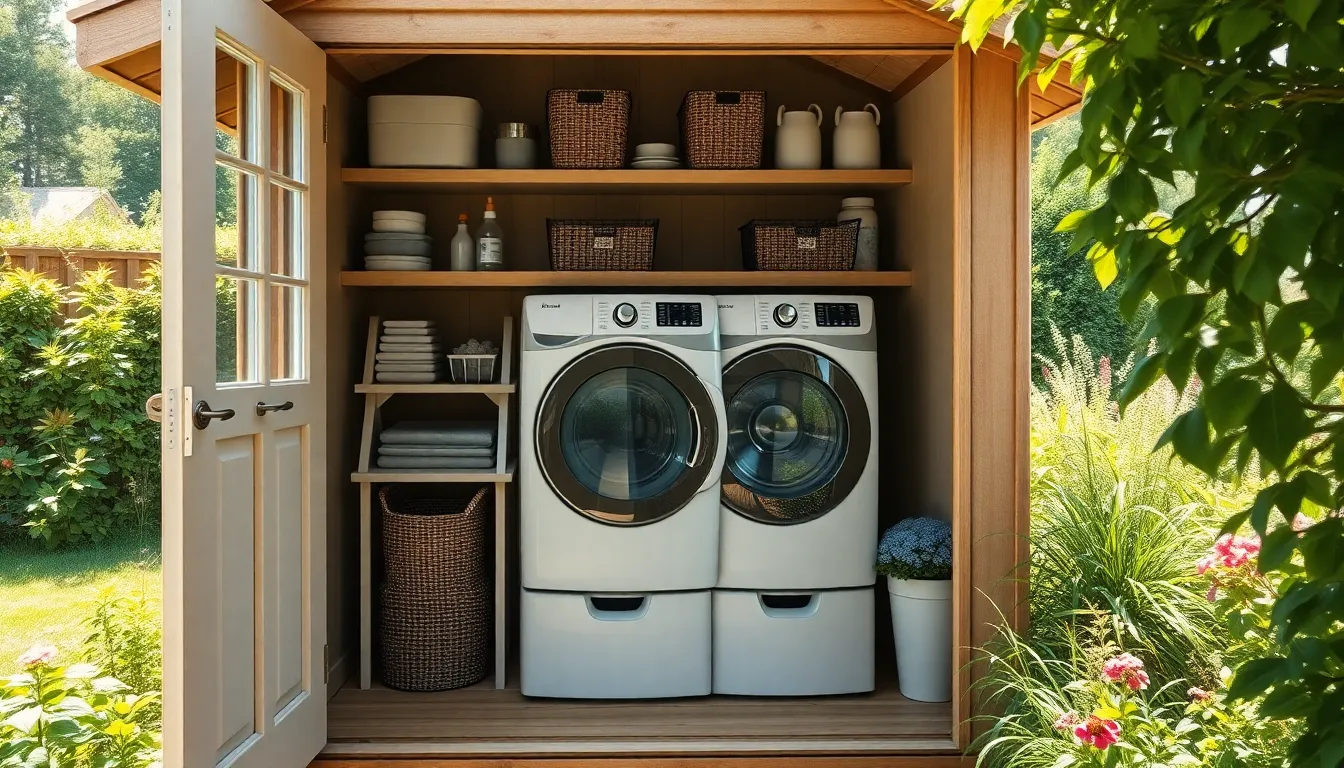
Converting a garden shed into an outdoor laundry space offers excellent weather protection while maintaining the convenience of outdoor washing. This setup allows us to create a dedicated area that’s both functional and protected from the elements.
Select Appropriate Shed Dimensions
Choose a shed size that accommodates both washer and dryer units comfortably with room for movement and storage. We recommend a minimum space of 6 feet by 8 feet to allow adequate room for appliances, venting, and user access. Larger sheds provide additional benefits like storage space for laundry supplies and folding areas.
Ensure the shed floor is level and sturdy enough to support the weight of the machines. Standard washers typically weigh between 150-220 pounds, while dryers range from 100-150 pounds when empty. We need to verify that our shed’s foundation can handle this combined weight plus the ever-changing loads from machine operation.
Consider ceiling height requirements for proper ventilation and maintenance access. Most standard sheds offer 7-8 feet of clearance, which provides sufficient space for dryer venting and allows us to service the appliances comfortably.
Install Weatherproof Electrical Connections
Install dedicated electrical circuits for the washer and dryer following manufacturer specifications and local codes. Washers typically require 120V outlets, while electric dryers need 240V connections. We must ensure each appliance has its own dedicated circuit to prevent overloading.
Use weatherproof outdoor electrical boxes and covers to protect outlets and connections from moisture. These specialized components feature gaskets and seals that prevent water infiltration, which is crucial for maintaining electrical safety in outdoor environments.
Ensure the dryer vent and electrical cords are properly shielded and sealed against the elements. We need to connect the vent hose securely with clamps or metal tape to maintain a tight seal and proper airflow. All wiring must include UL-listed strain reliefs and proper conductor cables with sufficient length for maintenance access.
Confirm that exterior vent installations remain clear and undamaged. Regular inspection of the exterior vent prevents lint buildup and ensures efficient dryer operation while maintaining proper ventilation.
Create Efficient Workflow Layout
Position washer and dryer units side by side or stacked to streamline the laundry process. Side-by-side placement works best in larger sheds, while stacking maximizes floor space in smaller areas. We should avoid pushing appliances directly against walls to prevent vent damage and allow proper airflow.
Keep water supply and drainage pipes accessible and well-insulated if in cold climates. Proper insulation prevents freezing during winter months, while accessible placement allows for easy maintenance and repairs when needed.
Allow adequate space for sorting, folding, and storage of laundry supplies within the shed. We recommend dedicating at least 2-3 feet of workspace for these activities, along with shelving or cabinets for detergent, fabric softener, and other essentials.
Consider lighting and ventilation adequacy for comfort and appliance longevity. Natural lighting through windows or skylights reduces electricity costs, while proper ventilation prevents moisture buildup that could damage both appliances and shed structure.
Design a Pool House Laundry Area
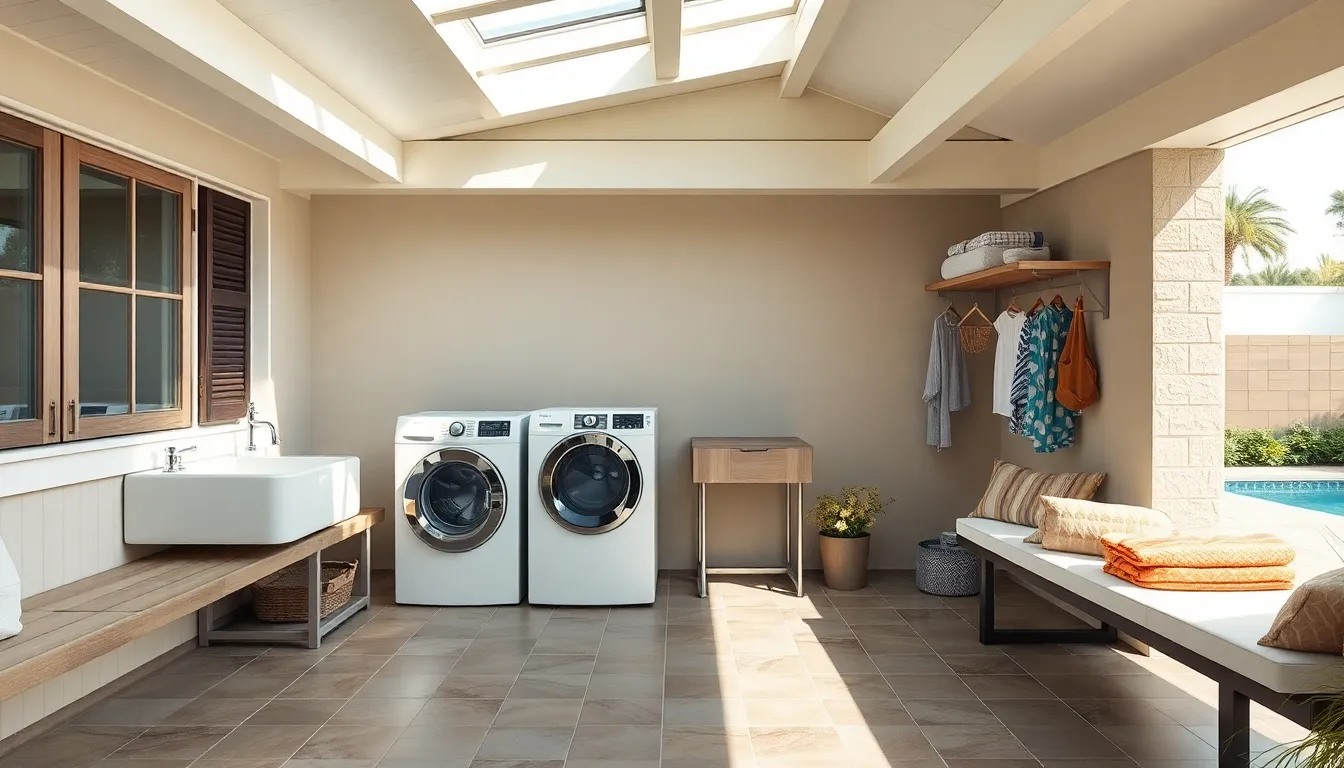
Pool house laundry areas offer the perfect blend of convenience and style for homeowners who want to maximize their outdoor living spaces. We’ll show you how to create a fully functional washing station that complements your poolside lifestyle.
Combine Recreation and Utility Functions
Position your washer and dryer strategically near pool lounges or outdoor seating areas to optimize convenience for wet swimwear and towel management. Create a seamless flow between recreational zones and utility functions by incorporating comfortable seating or small tables adjacent to your appliances. Blend leisure with functionality by adding weather-resistant benches where family members can sit while waiting for wash cycles to complete.
Install durable, water-resistant materials like tiled floors and walls to handle moisture from both pool activities and laundry operations. Integrate natural lighting with windows or skylights to brighten the space and create visual connections between indoor and outdoor areas. Design the layout so users can easily transition from pool activities to laundry tasks without disrupting the recreational atmosphere.
Plan for Wet Swimwear Handling
Designate exact storage spots for wet swimwear using stainless steel hooks, expandable drying racks, or waterproof baskets to keep damp items separate from dry clothing. Install a utility sink or basin specifically for hand-washing delicate swimwear or rinsing off chlorine and sand before machine washing. Ensure proper ventilation and drainage systems prevent moisture buildup and eliminate odors that can develop from wet pool gear.
Create designated zones for different types of wet items, such as separate areas for chlorinated swimwear versus sandy beach towels. Add removable mesh bags or laundry baskets that allow water to drain while keeping wet items contained and organized.
Include Folding and Sorting Stations
Allocate generous counter space or large tabletops dedicated to folding clothes and efficiently sorting laundry loads by fabric type or family member. Choose weather-resistant surfaces that withstand outdoor elements, including natural stone, ceramic tile, or marine-grade treated wood that won’t warp or fade. Provide smart storage answers for detergents and supplies using sealed cabinets or repurposed antique drink servers that add rustic charm while protecting items from moisture.
Design multiple work zones with different heights to accommodate various users and tasks, from sorting dirty clothes to folding clean linens. Include pull-out drawers or sliding baskets beneath countertops for temporary storage of sorted items before they’re processed or put away.
Set Up a Garage Extension Laundry Zone
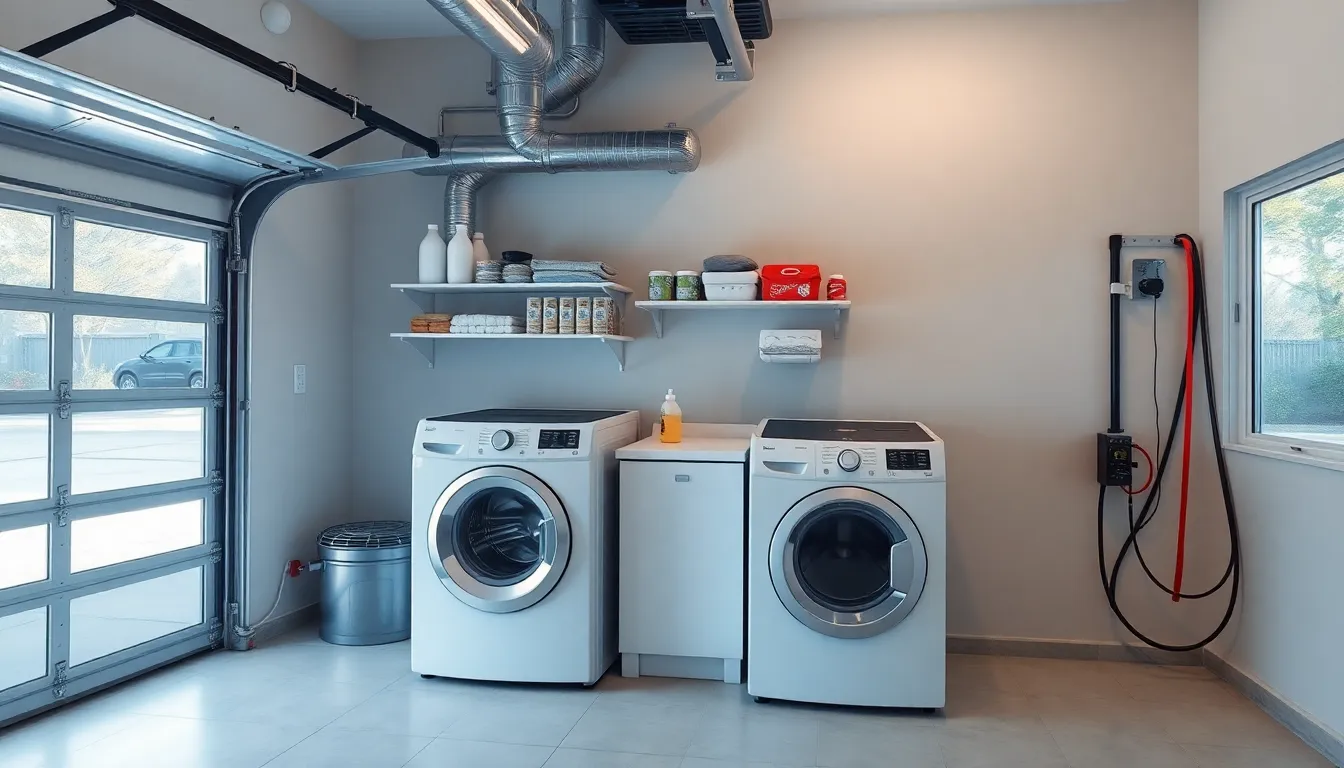
Building on our previous outdoor laundry answers, extending your garage space offers a practical middle ground between fully outdoor setups and indoor installations. This approach provides weather protection while maintaining the ventilation benefits we’ve discussed.
Convert Unused Garage Space
Transforming underutilized garage corners or sections creates a functional laundry area without sacrificing storage space. We recommend starting with plumbing hookups by teeing into existing water supply lines and installing proper drainage systems using durable PEX and PVC fittings. Installing washer/dryer combos in these spaces requires electrical work including GFCI-protected outlets and dedicated circuits.
Ventilation becomes crucial in garage conversions since we’re working in a semi-enclosed environment. Installing ventilation ducts for dryer exhaust prevents moisture buildup and lint accumulation. Adding extra bracing under countertops helps support the machines’ weight and prevents movement during operation.
Tiled flooring provides durability and water resistance while making cleanup easier. Reinforcing wall studs ensures secure mounting points for cabinets and shelving units. Planning the layout around existing garage infrastructure saves installation costs and maintains the space’s dual functionality.
Maintain Vehicle Access Points
Preserving vehicle access requires strategic planning when designing garage extension laundry zones. We suggest using compact or stackable washer/dryer units to maximize floor space and keep pathways clear. Positioning appliances along walls prevents interference with garage door operation and vehicle movement.
Installing platforms or stands raises machines to convenient working heights without blocking entryways. Wall-mounted storage answers keep detergents and supplies organized while preserving floor space. Planning electrical and plumbing runs along existing walls maintains clear traffic patterns.
Designing the space with swing clearances in mind ensures both appliances and garage doors operate smoothly. Using ceiling-mounted storage racks maximizes vertical space without impeding vehicle access. Installing fold-down work surfaces provides temporary counter space that doesn’t permanently reduce parking area.
Add Climate Control Features
Climate control protects both appliances and users in garage extension laundry zones where temperature fluctuations occur. We recommend installing insulated enclosures with weatherproof doors to regulate temperature and humidity levels. Adding electric heaters or fans helps mitigate extreme temperatures that could damage machines or affect drying performance.
Incorporating fully enclosed sections with tiled walls and floors provides moisture control and temperature stability. Installing exhaust fans removes excess humidity and lint while maintaining air circulation. Using weatherstripping around doors and windows prevents drafts and maintains climate control efficiency.
Adding antique storage answers like labeled containers keeps detergents organized while protecting them from temperature extremes. Installing moisture barriers prevents condensation buildup that could damage stored supplies. Planning ventilation systems with automatic controls maintains optimal conditions without constant manual adjustment.
Build a Standalone Outdoor Laundry Cottage
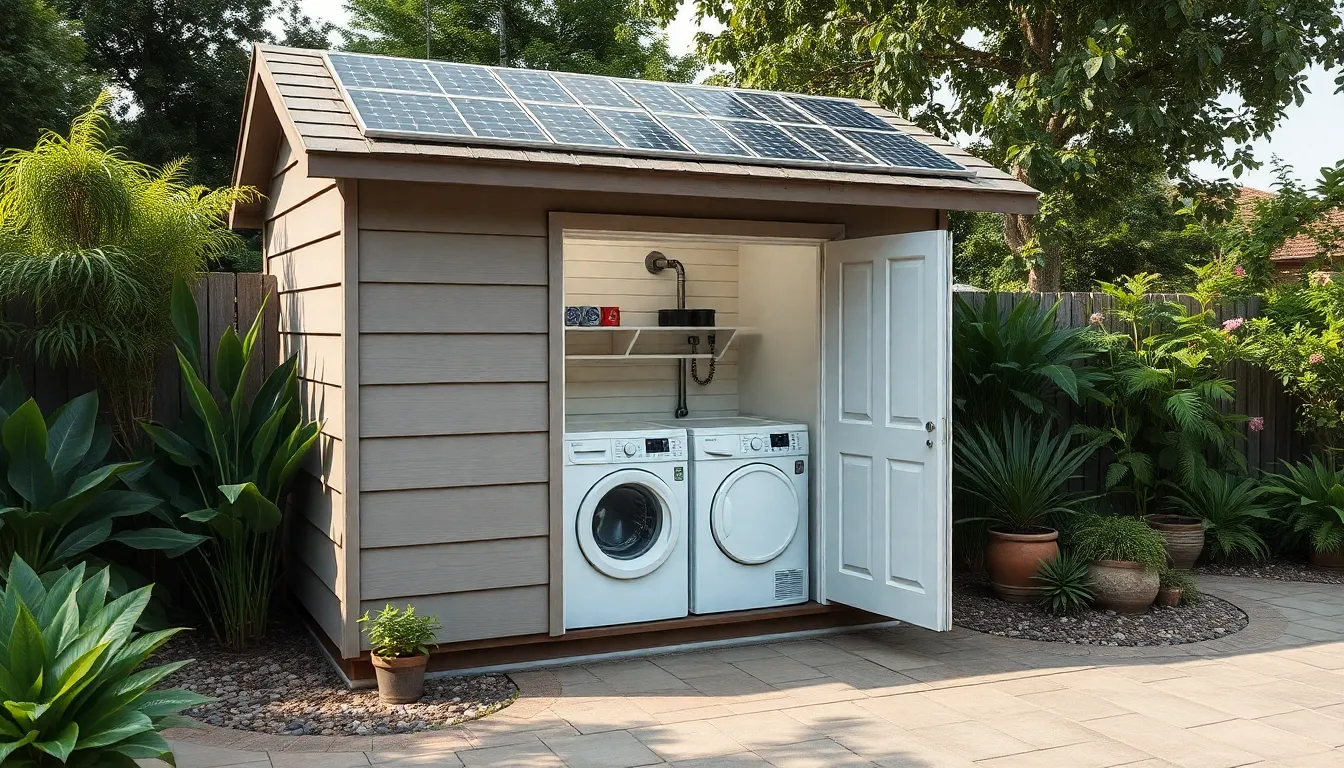
Creating a dedicated outdoor laundry cottage offers the ultimate solution for homeowners seeking a permanent, weather resistant washing station. This approach provides complete protection for your appliances while maintaining the benefits of outdoor laundry operations.
Plan for Year-Round Weather Protection
Fully enclose your washer and dryer units within a custom built shed or cottage to shield them from rain, wind, and extreme temperatures while maintaining proper ventilation for safe dryer operation. Weather resistant materials form the foundation of effective protection.
Waterproof tiles provide exceptional durability for both floors and walls, handling moisture exposure while reducing long term wear on your cottage structure. These materials withstand constant humidity and temperature fluctuations better than standard indoor options.
Install comprehensive drainage systems around your laundry cottage perimeter to manage runoff and prevent water damage to the foundation. Gutters direct rainwater away from the structure, while proper grading ensures surface water flows away from the building.
Weather resistant siding protects exterior walls from harsh outdoor conditions, extending the life of your investment. Composite materials or treated wood siding offer superior protection against moisture, insects, and UV damage.
Auxiliary water pressure systems may be necessary for remote cottage locations where standard household pressure isn’t sufficient for optimal washer performance. Booster pumps ensure consistent water flow regardless of your cottage’s distance from the main house.
Include Comfortable Working Environment
Soundproofing elements like tiled walls help dampen noise from running machines, particularly important when your laundry cottage sits near outdoor living spaces or neighboring properties. Strategic material choices reduce operational noise significantly.
Adequate lighting systems create pleasant working conditions for folding, sorting, and organizing clothes in your outdoor space. Natural light through windows combined with overhead fixtures provides optimal visibility throughout the day.
Strategic shelving and cabinetry maximize organization while keeping laundry supplies easily accessible. Built in storage answers work better than portable options in outdoor environments, resisting weather related damage.
Proper workspace planning includes dedicated areas for different laundry tasks, from sorting dirty clothes to folding clean items. Counter space and hanging areas make the cottage functional for complete laundry processing.
Professional venting duct installation directs dryer exhaust safely outside while reducing indoor humidity and heat buildup. Proper exhaust systems prevent moisture problems that could damage your cottage structure.
Design for Energy Efficiency
Energy efficient washer and dryer models with silent operation features save electricity while minimizing disturbance to your outdoor living areas. Modern appliances offer superior performance with reduced environmental impact.
Solar panels integrated into cottage design provide sustainable power for your outdoor laundry operations, reducing utility costs while supporting off grid functionality. Renewable energy answers work particularly well for standalone structures.
Smart water management systems optimize usage through efficient pumps and booster equipment that deliver necessary pressure without wasting resources. Modern pump technology provides consistent performance with minimal energy consumption.
Insulation strategies balance protection with ventilation needs, maintaining comfortable temperatures while preventing energy waste. Proper insulation reduces heating and cooling costs in climate controlled cottage designs.
LED lighting fixtures consume minimal electricity while providing excellent illumination for detailed laundry tasks. Energy efficient lighting extends operating hours without significantly impacting power consumption.
Create a Mobile Outdoor Laundry Cart
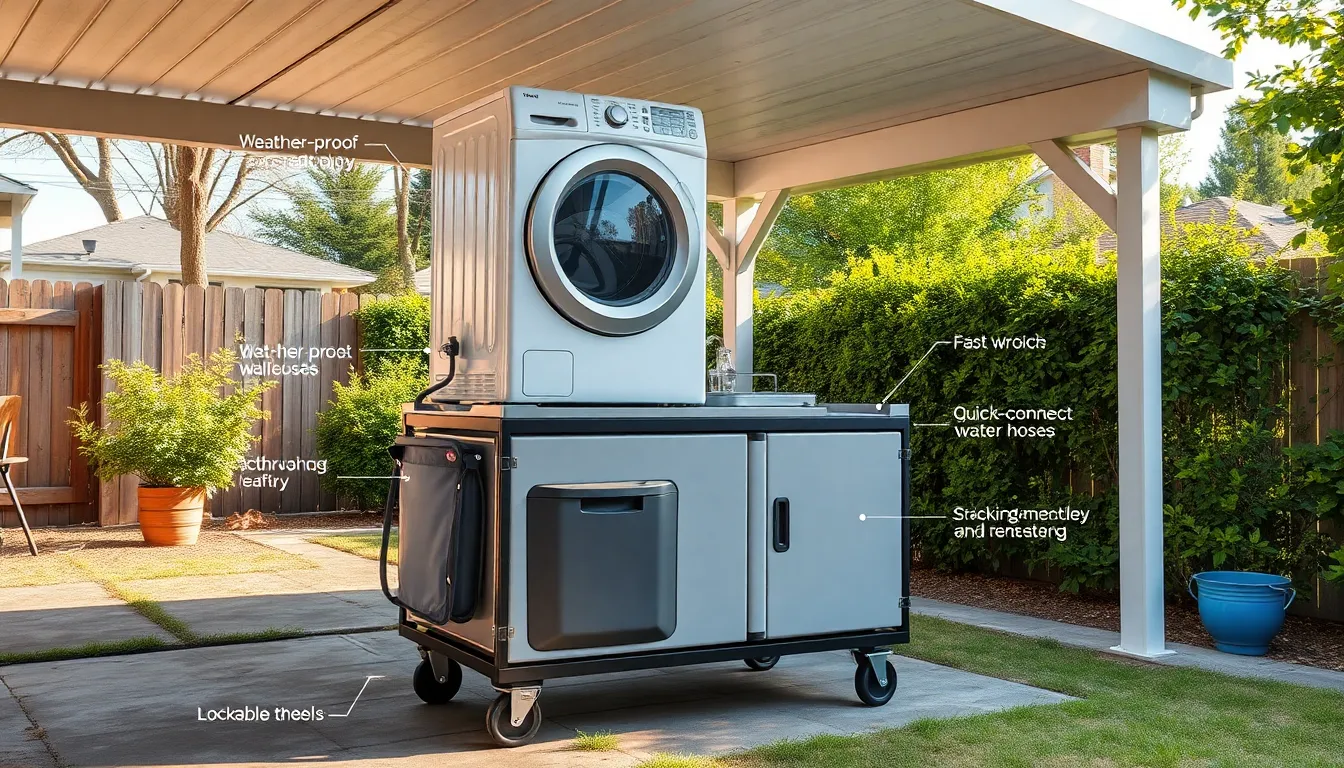
Mobile laundry carts bring flexibility to outdoor washing setups while offering the convenience of moving your appliances wherever you need them. We can build or purchase wheeled platforms that transform any outdoor space into a functional laundry area.
Choose Portable Washer and Dryer Options
Portable washers and dryers deliver the perfect solution for mobile outdoor laundry stations. We recommend selecting lightweight models designed specifically for outdoor use with weather-resistant features and easy water connections. Electric dryers work well with proper outdoor electrical access, while gas-powered units offer powerful drying capabilities for larger loads.
Stacked portable units maximize our cart space while maintaining full washing and drying functionality. These compact appliances typically weigh between 50-100 pounds, making them manageable for mobile setups. Many models connect directly to garden hoses and standard outdoor electrical outlets, eliminating complex plumbing requirements.
Design Weather-Protected Storage
Weather protection becomes essential when storing our mobile laundry cart outdoors. We can create removable covers using waterproof materials like vinyl or marine-grade canvas that slip over the entire cart during storms or extended periods of non-use. Rolling covers with elastic edges provide quick protection while maintaining easy access.
Built-in storage compartments on our cart should feature sealed containers for detergent and fabric softener to prevent moisture damage. We recommend adding small cabinets with weather-stripping around doors and drawers to keep supplies dry. Installing a fold-down work surface with raised edges helps contain water splashes during operation.
Positioning matters significantly for weather protection. We should design our cart to roll easily under covered patios, overhangs, or into garages when severe weather threatens. Adding a protective platform or mat beneath the cart prevents ground moisture from affecting our appliances.
Plan for Easy Setup and Breakdown
Quick connection systems make our mobile laundry cart practical for regular use. We can install quick-disconnect fittings on water hoses that snap onto outdoor faucets without tools. Retractable cord reels keep electrical connections organized and prevent tripping hazards while providing easy access to power sources.
Lightweight construction enables effortless movement between storage and use locations. We recommend using aluminum frames or high-quality plastics that resist rust and corrosion while keeping the overall weight manageable. Lockable wheels prevent unwanted movement during operation but allow smooth transport when needed.
Storage preparation simplifies breakdown after each laundry session. We can add drainage plugs to remove standing water from washers and built-in holders for hoses and power cords. Creating a systematic approach to folding, disconnecting, and storing components ensures our mobile setup remains ready for the next use while protecting equipment from the elements.
Install Outdoor Laundry Hookups Only
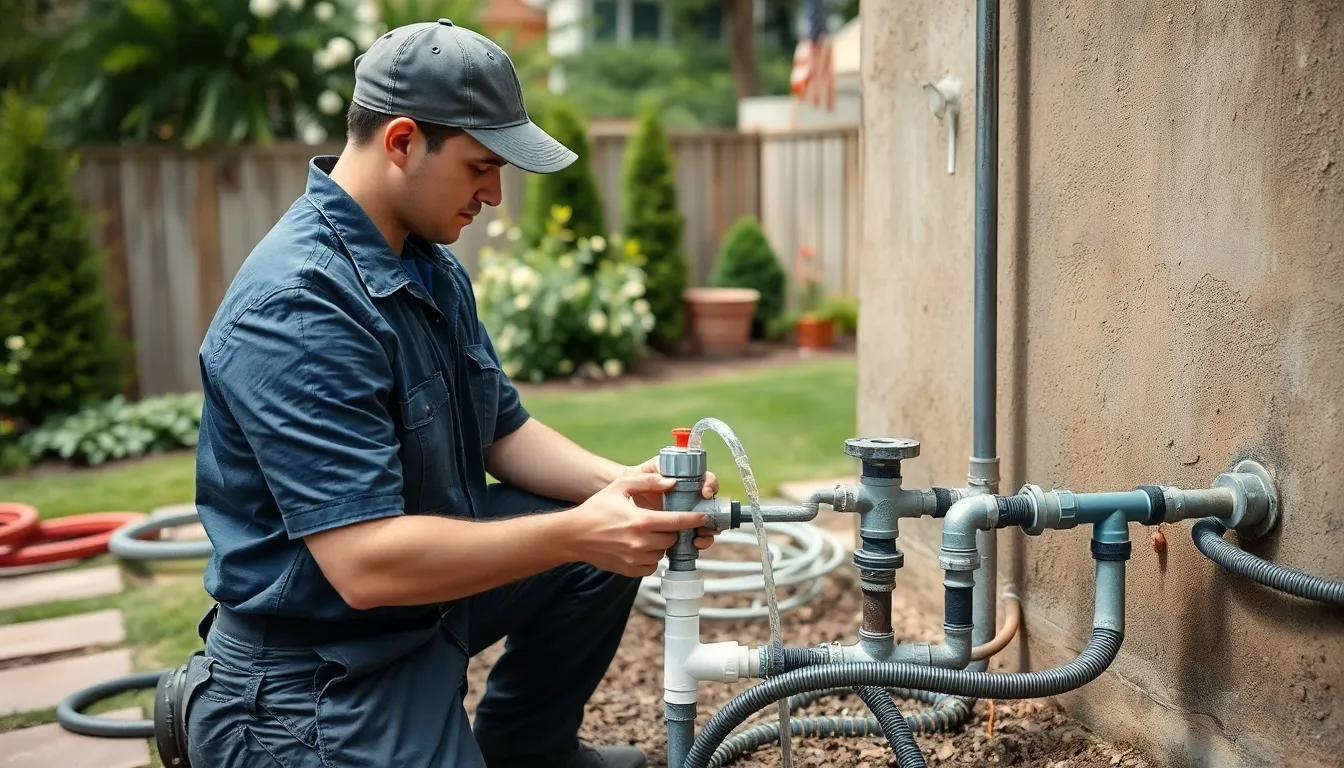
Building on the foundation of our previous outdoor laundry answers, we’ll now focus on the critical infrastructure that makes these setups possible. Professional installation of utility connections ensures your outdoor washing station operates safely and efficiently.
Prepare Essential Utility Connections
Water supply and drainage systems form the backbone of any outdoor laundry installation. We recommend installing outdoor faucets specifically designed for washer use, ensuring proper water pressure reaches both hot and cold connections. Professional plumbers should route waste water safely away from your home’s foundation through dedicated drainage lines.
Electrical power requirements vary significantly between washer and dryer types. Electric dryers need outdoor-rated, grounded outlets on dedicated circuits with proper strain relief and grounding to prevent electrical hazards. Gas dryers require professional installation of gas lines with shutoff valves positioned for easy access during maintenance.
Ventilation systems prove crucial for dryer safety and performance. Exhaust vents must lead directly outside through unobstructed ducts that remain properly sealed and weatherproofed against outdoor elements. We’ve found that maintaining clear ventilation paths prevents moisture buildup and ensures optimal dryer efficiency.
| Connection Type | Professional Required | Key Safety Features |
|---|---|---|
| Water Supply | Plumber | Proper pressure, code compliance |
| Electrical | Electrician | GFCI protection, dedicated circuits |
| Gas Lines | Licensed technician | Shutoff valves, leak testing |
| Ventilation | HVAC specialist | Weatherproof seals, clear paths |
Create Temporary Setup Answers
Washer/dryer combo units offer flexibility when permanent hookups aren’t feasible. These units connect directly to outdoor faucets and drain into buckets or designated garden areas, making them perfect for seasonal use. We suggest positioning temporary units under covered porches or sheds to protect them from direct weather exposure.
Extension hoses and outdoor-rated power cords provide connectivity for temporary setups. But, we emphasize using only equipment specifically rated for outdoor conditions to avoid safety hazards. Quick-disconnect fittings make setup and breakdown processes more efficient for occasional use.
Portable answers work best for homeowners who need occasional outdoor laundry capacity. We recommend investing in units with built-in weather protection features and easy-connect systems that simplify the installation process.
Plan for Seasonal Use Patterns
Cold climate considerations require special attention to prevent freeze damage. We recommend insulating exposed pipes and hoses or installing drain valves that allow complete water removal during winter months. Covered or enclosed outdoor laundry spaces extend usability throughout harsh weather seasons.
Warm climate installations benefit from open-air or screened enclosures that promote ventilation while protecting machines from direct sun and rain. We’ve observed that strategic positioning under natural shade or installing UV-resistant covers significantly extends appliance lifespan in sunny regions.
Year-round functionality depends on matching your setup to local weather patterns. Enclosed structures work well in areas with frequent precipitation, while open designs suit consistently dry climates. We suggest consulting local building codes to ensure your seasonal plans comply with regional requirements.
Conclusion
Creating an outdoor laundry space transforms how we approach this everyday chore while maximizing our home’s functionality. Whether we’re building a dedicated laundry cottage or setting up a mobile cart solution we’ve explored options that work for every budget and space constraint.
The key to success lies in proper planning—from weatherproofing and ventilation to electrical and plumbing considerations. We’ve shown that outdoor laundry setups aren’t just practical but can enhance our property value and outdoor living experience.
With the right approach any homeowner can create an efficient washing station that stands up to the elements. These outdoor answers free up valuable indoor space while providing the convenience and functionality we need year-round.
Frequently Asked Questions
What are the main benefits of moving laundry appliances outdoors?
Outdoor laundry setups provide better ventilation, reduce indoor humidity, and eliminate lint buildup inside your home. They free up valuable indoor space while creating functional outdoor living areas. Additionally, outdoor installations offer excellent airflow for faster drying and help prevent moisture-related issues that commonly occur with indoor laundry rooms.
What materials work best for outdoor laundry installations?
Weather-resistant materials are essential for outdoor laundry setups. Concrete, pressure-treated lumber, vinyl siding, and composite decking provide excellent durability against the elements. For storage solutions, use weather-resistant cabinets and sealed containers. Waterproof tiles are ideal for flooring, while stainless steel or powder-coated metal fixtures resist rust and corrosion.
How do I protect outdoor laundry appliances from weather?
Create covered structures like patios, shed conversions, or standalone cottages to shield appliances from rain and direct sunlight. Use raised platforms to prevent water damage, install proper drainage systems, and ensure adequate ventilation. Consider removable covers for portable setups and weatherproof electrical connections with GFCI protection for safety.
What ventilation requirements are needed for outdoor laundry setups?
Proper ventilation prevents moisture buildup and ensures safe dryer operation. Install exhaust fans, ridge vents, and louvered panels for air circulation. Professional venting duct installation is crucial for dryers. Open-air structures should maximize airflow, while enclosed spaces need comprehensive ventilation systems to manage humidity and lint effectively.
Can I set up a temporary outdoor laundry solution?
Yes, mobile outdoor laundry carts offer flexibility with portable washer and dryer units designed for outdoor use. Choose lightweight, weather-resistant models with quick connection systems for easy setup and breakdown. Include weather-protected storage with removable covers and built-in compartments to keep supplies dry when not in use.
What electrical and plumbing considerations are important?
Professional installation is essential for utility connections including water, electricity, and gas lines. Install GFCI-protected outlets for electrical safety, ensure proper drainage with P-traps and dedicated drain lines, and plan for adequate water pressure. Consider electrical capacity requirements and local building codes when planning your outdoor laundry installation.
How can I maximize storage in outdoor laundry spaces?
Utilize wall-mounted storage solutions, built-in cubbies, and hanging organizers to maximize space efficiency. Weather-resistant cabinets, sealed storage containers, and repurposed furniture work well for organizing supplies. Include folding and sorting stations with generous counter space and smart storage solutions to maintain a clean, organized workspace.
What should I consider for year-round outdoor laundry use?
Plan for seasonal weather patterns with insulated enclosures, climate control features like electric heaters or fans, and moisture barriers. Install comprehensive drainage systems and watershed management. Consider soundproofing for enclosed structures and ensure adequate lighting for comfortable use during shorter winter days.

